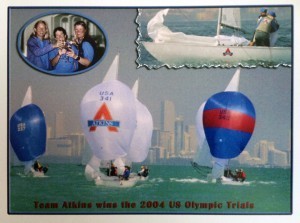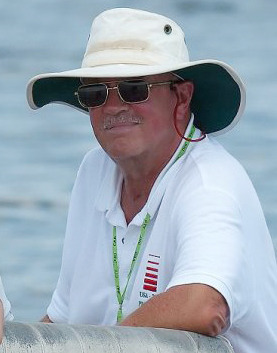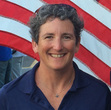Carol Newman Cronin's Blog, page 54
August 28, 2014
Rewarded for Hard Work: Snipe Camp
We hear it all the time: “work hard and you will be rewarded.” But how often can we really “see” those rewards? Too often they are either so vague or so far in the future, they don’t seem real.
Except for sailboat racing, where the rewards for hard work can often be instantaneous.
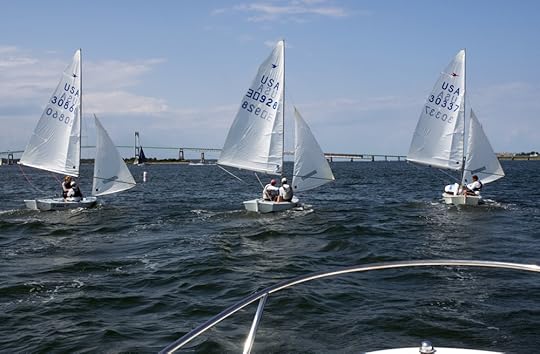
Snipe Camp 2014 was a reward in itself. Photo: PaulCroninStudios
Last February, Kim Couranz and I qualified for the Snipe Western Hemisphere and Orient Championship, which takes place September 6-12, 2014 in San Diego. The “Westerns” or “WHO” is an international event similar to the Worlds, except that it excludes the Europeans (who had their own very tough 2014 event).
With an international regatta on our horizon again we stepped up our game, though that may not have been apparent to anyone but us; on the surface, we were just showing up for regattas as always, racing hard and laughing afterwards at our mistakes. The difference was very subtle: a renewed focus on improving our boat speed—which was fine, but we were ready to take the next step. And we’d been sailing the boat long enough to realize that climbing the next few ladder rungs would require subtle changes that would likely have unexpected consequences and therefore require other changes.
The Snipe rig is a bit quirky in how it reacts to changes in velocity, crew weight, sailing style, and sail trim; we’d already mastered the basic tuning setup, so it was time to develop our own numbers that would keep us fast through a large range of conditions. Since we’re lighter than most of our competitors, we couldn’t just copy the fast settings of others; we had to first understand the variables, and then try to tune our boat for us. Luckily, we have a lot of smart friends who’ve put a lot of thought into Snipe tuning, which turned into a lot of fun conversations.
Everyone of course had a different opinion, so we quickly realized we just needed to go sailing. Only through time on the water could we experiment and see what worked for us. And tuning at regattas wouldn’t work, because there wasn’t enough time to try anything new. We needed a training camp.
And so was born what turned out to be the highlight of my summer: “Snipe Camp,” a two day speed testing session, somehow jammed into the week between two regattas in Boston. We brought together a coach, coach boat, and a group of fast Snipe teams who all, amazingly, left the dock at around the same time—which may not sound like much, but the number of phone calls, texts, and emails involved was pretty staggering. Thanks to my Snipe Camp crew, Jess Claflin, for jumping in and helping us go fast while Kim was stuck at work.
Luckily the conditions (on the only two days that fit into all of our schedules) turned out to be perfect, with flat water and a steady 10-12 knot breeze that allowed us to see the effects of any change no matter how small. Our close lineups provided all the adrenaline of racing—but when someone fell behind, the rest would wait up and start again.
(And since Snipe competitors are also Snipe friends, the after-tuning dinner parties went on far too late. Serious Sailing, Serious Fun®, just like the class motto promises.)
Best of all, we were instantly rewarded for all that hard work (cerebral, logistical, and physical). The very next weekend we sailed the North Americans during a breezy three days in Boston Harbor, with 36 other Snipes and fairly long courses. In 11th after the first day, we climbed to 8th after the second day, and then to a final 6th place overall after finishing second in the last race of the regatta. Best of all, we were making use of those small adjustments we’d learned, to keep us going fast as conditions changed. “It’s not rocket surgery,” as Alex Pline (Snipe sailor and rocket scientist) likes to say.
Kim and I sailed the 2010 Westerns, and it was a very deep and tough fleet (though not as hard as the 2011 Snipe Worlds). So my expectations for 2014 are suitably reigned in. But no matter how we end up at that event, I’m feeling rewarded for all our hard work leading up to it.
And I’m already starting to think about Snipe Camp 2015.
July 10, 2014
High Summer: Making Those February Dreams Come True
New Englanders look forward to it all winter: the few months of the year when the water and air are warm enough to sail in shorts and a T-shirt. And it’s here: High Summer. Between Memorial Day and the dog days of August, the crazy dreams of ice-bound February still all seem possible: I will Sail Every Day. I will Swim Every Day. I will Go To the Beach Every Day. I will Sail Around Conanicut Island. I will Go Cruising in Maine. I will Sail Every Snipe Regatta.
This year I’m doing a good job of checking off that list, except for the really crazy ones (I don’t even like the beach). The past two months, Narragansett Bay has been teeming with boats large and small, criss-crossing from Newport to Jamestown or beating out East Passage to the open waters of Rhode Island Sound, and all of them are filled with sailors trying to check off their summer lists. The breeze has been strong and consistent, but warm—a combination we only get during High Summer.
I haven’t sailed every day, but I’ve been averaging 4-5 days a week which is pretty good (especially compared to February). And I haven’t gone swimming every day either, but I’ve been jumping in after most of my morning paddles. A few days ago, I paddled, swam, sailed, did a few chores, and swam again. That was a great day.
The sand in the hourglass of summer is already emptying, and I won’t achieve several of those crazy thoughts from February this year—or probably ever. But for once I feel like I’m taking advantage of living so close to the ocean, balancing the demands of work with the seasonal potential for play, spending as much time on the water as possible without letting too many things slide. I’m building up a nice reserve of memories, which might just help keep me warm once February rolls around again.
I hope many of your High Summer dreams are coming true as well.
May 29, 2014
Casual Sailboat Racing: Saved by a Sneaker
Last weekend I was invited/asked/arm-twisted to help run the West Ferry Laser Invitational, a casual event in our back yard. The organizers, Dan and Karen Neri, knew other Laser sailors would really like racing in the West Passage of Narragansett Bay. After all, what’s not to like? We’ve got the same reliable breeze as Newport’s East Passage, but without the traffic and mixed-up sea state of too many powerboats going every direction. So after thinking about it for a few years, they organized an “event”, which Dan dubbed the “First and Last Invitational.” That way there’s no pressure to do this again next year, unless we all want to. (Though judging by the atmosphere at the after-race party, we’ll all want to.)
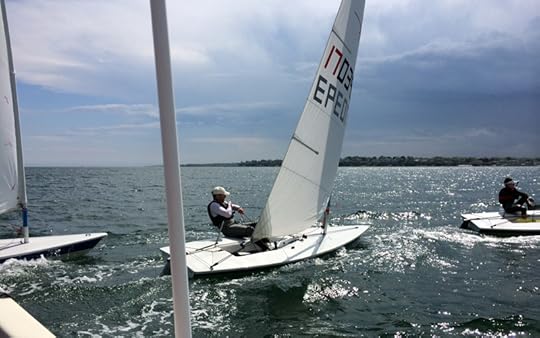
All 14 Lasers rounded the committee boat for the final run, a great photo op.
Now when I say “organize,” here’s what they did: they sent out a few emails, bought a few burgers (veggie and otherwise), and loaded up on beer of various types. Then they rounded up a race committee of five dinghy sailors, borrowed marks and an automatic timer from Sail Newport, found a second powerboat to move marks, et voilà! It’s a regatta.
No trees were harmed by printing scads of sailing instructions. No valuable time was wasted on a skipper’s meeting, though I’m sure Dan answered a few questions while the fleet rigged up on the beach. We all knew what was important: running as many decent races with clean starts as we could fit into an afternoon, keeping track of the scores, and having a great party afterward.
The main committee boat was normally used for harbor cruises, so we had to improvise on a few things. The most visible example of repurposed equipment was at the boat end of the starting line, which we made more visible by adding an orange-soled sneaker to the top of the boathook. Orange-side out, of course. If it didn’t work, no one complained; perhaps the sailors realized that if we’d had a flag of any sort, it would’ve already been flying.
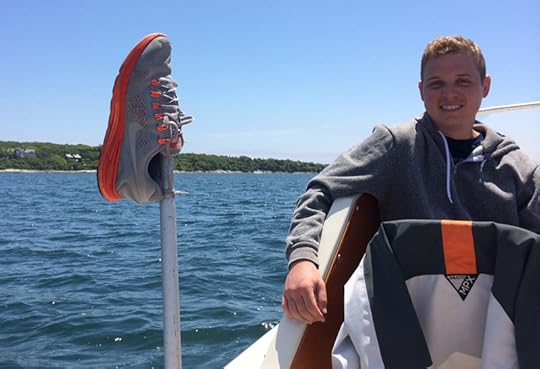
The sneaker that saved the day and made the starting line visible, and Matt, its owner.
The sailboats (14) outnumbered the powerboats (2), unlike what we see at many big regattas these days. The courses were varied and included a “Harry A,” which used the committee boat as a turning mark and led to some great action photos. As long as we had the line within range of square, the starts were amazingly even. And only one of the five races had a course skewed enough to be obvious, at least from a race committee boat with a shoelace for a telltale.
There is a place in the sailing world for perfection. I would be very disappointed to get to a top level championship and find some hack like me running the event, instead of experts like Tom Duggan and Hank Stuart and all the others who take race committee work so seriously. But for casual Sunday racing, maybe we should dial back the quest for perfection. Because as it turns out, all you need to run a sailboat race is an automatic timer, a couple of marks, and an orange-bottomed shoe on top of a boat hook.
April 11, 2014
Remembering Our 2004 Olympic Trials Win
The memories just won’t fade. It’s been 10 years and 47 days since we won the 2004 Yngling Olympic Trials and earned the right to represent the U.S. at the 2004 Games in Athens. And in some ways it still seems like yesterday.
The photos make it obvious that we were all 10 years younger. But the details shine on into their second decade, polished only by my smile.
It seems impossible now that we all left our jobs and lives behind to move to Miami to train, but it was just one of many choices we all made to put this crazy dream at the top of our life lists. Liz Filter, Nancy Haberland and I were all equally committed to “Going all the way, baby” (as Liz put it, way back in 2002). Winning the Trials was not the ultimate goal, but it was a necessary and huge hurdle on the way to becoming an Olympian.
I wrote a short blog for boats.com about my favorite memory of all from a decade ago (read Throwback Thursday: Our Olympic Trials Win) There were so many great moments, it was hard to pick… but this one was a watershed for sure. Back when we were Team Atkins, before we had to pull all the logos off the boat for the Olympics, we peaked at the right time… and beat out a bunch of really good teams for the ultimate prize, an Olympic berth. No wonder the memories are still so shiny.
April 3, 2014
Eight Bells: Bob “Buddha” Billingham
It seems we are losing members of the sailing family left and right these days: Hugh Elliot. Hans Fogh. Hobie Alter. Steve Black. My own sailing mentor, Bob Bigelow.
And even among such illustrious company, Bob “Buddha” Billingham still stands out.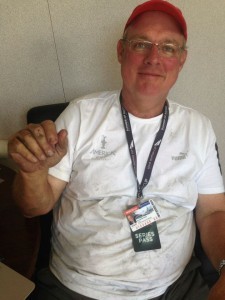
Bob was the most “get it done” guy I’ve ever met. (And for those of you who know my husband, that’s saying a lot.) By the time I joined Bob on the Olympic Sailing Committee in 2005, we were both past our Olympic sell-by dates. But even two decades after he’d won a silver medal (Korea 1988, in the Soling with John Kostecki and Will Baylis), Bob still brought an Olympian’s mentality to everything he did. There was no obstacle too large to overcome—assuming the end goal was worth it.
I’m sure there were other end goals in Bob’s life, including work and family and the America’s Cup. But because Bob never talked about his successes, and actively discouraged anyone else from talking about them either, the only place I saw his impact was in person, on the Olympic Sailing Committee. He got what was different about the world of Olympic sailing in the 21st century—and what was still very much the same. We all like to talk about “back in the day,” but Bob’s stories had a point that was pertinent to the challenges facing today’s athlete.
He was always cutting through the distracting details and bringing us back to our real mission: giving Olympic hopefuls what they need to succeed on the world stage. And he never wanted credit for any of this; he just wanted to know that he’d helped remove a few of the many impediments to success for those trying to win an Olympic sailing medal. He was never afraid to take on the big problems, and he could make the leap from tiny detail to a short, pithy sentence stating “why this is important” in a heartbeat—an invaluable skill on a committee.
The best concrete (sic) example of this was “The Shed”, a building just outside the gates of the 2012 Olympic Sailing venue in Weymouth, England, that Bob helped to secure for US athletes in July of 2008—a few months ahead of the predictable skyrocket in property values, while most countries were still focusing on supporting their athletes in Qingdao, China. US sailors had a private space a few steps from the Olympic venue where they could work out, unwind, and just be themselves—a complete novelty within the Olympic pressure-cooker.
My favorite story about Bob dates back to spring 2012, when most of our team had been selected and all eyes were firmly focused on those Games in England. To open what we thought would be a routine meeting, the OSC Chair, Dean Brenner, shocked us all with an announcement: we’d just had a sudden and completely unexpected reduction in our funding for the upcoming Games. While the rest of us around the table were still trying to digest the details, Bob with his characteristic smile said, “That sounds like a great opportunity.” And within minutes, we were on our way to planning the next step—which turned out to be even better than our original plans.
We will miss you, Buddha. You were a great visionary, and also a great friend—and a ton of fun to hang out with. Watch out, Hugh and Hans and Hobie and Steve and Bobby… Those regattas in the sky are about to become a lot better managed.
April 1, 2014
Tired of Email? Try Pid-Me
In a surprising announcement, Google said today they were rolling out a new message service, Pid-Me.
“We simply got tired of having to respond to everyone so quickly—instantly,” Sergei Brin explained. “There’s no time anymore for contemplation or making wise decisions. So we’re bringing back the oldest form of message delivery and giving it a modern twist.”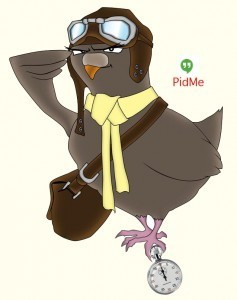
To send a Pid-Me, simply log into your Google account and choose the appropriate picon. 36 minutes later, a personalized avian carrier will land on your desktop and chirp a reminder. “Hello! Did you Pid-me?” Type in your message (assuming you still remember it) and the delivery address. The window is formatted like a Gmail window, though it fills the entire screen by default in order to reduce distractions.
When you’ve finished with your composition, click the bird’s stopwatch, and an accurate delivery will be made 24 minutes later—no matter where in the world your recipient is currently hiding.
You can also request a custom delivery time, as long as it’s more than 24 minutes. Up to ten messages can be saved for later delivery, up to ten years in advance. That makes Pid-Me a convenient option for birthdays and anniversaries you might otherwise forget.
“We hope this will encourage people to read their messages through at least twice before sending,” Brin said. “You can also ask your Pid for punctuation and spelling advice.”
For an additional fee, customers will have access to Pid-Psych. After reading your message, your pidgeon will then ask appropriate questions, including but not limited to: “Have you slept on this? Should you even have this person in your contacts?” “Did you really mean to swear so many times?” “Have you considered anger management?” And, of course, “What the hell were you thinking?”
Apple is rumored to be coming out with a Pid-Me plugin called the “i-Pid” that will allow your Pid to “learn” special quirks about your spelling and punctuation. The launch date is not certain, but it will follow closely on the same service actually working on the iPhone.
Customers are encouraged to comment about the service on the new Pid-Me page of the Google website, which hopefully will be live by next April Fool’s Day.
March 19, 2014
Time Capsule of Words: Yesteryear’s Crossword Puzzles
I’m a devoted Sunday New York Times crossword puzzler. So devoted, in fact, that I have a Crossword subscription to the Times. And last week I discovered a way to go back in time through words: the archives.
I figured I’d never remember the March 14, 2004 puzzle, and I was right—even though I’m sure I did my best to complete it on the day. But it felt different, looking back on the clues a decade later: the words we use have changed. Back before the financial meltdown, before “Madoff” was a modern name for “Ponzi”, back when phones were called “cell” phones… as the world moved on, so has our use of language. And since the best crossword puzzle clues are nuggets of language based on current dialogue, it’s easy to see the changes by stepping back only a few years.
Of course there are some throwbacks to Shakespeare, Caesar, and even Carole King. (Three letters, “____ Too Late”) But the best wordplay takes place in the language of today. As great crossword puzzle clue writers tighten and refine their word combinations into a kind of haiku, they tease out answers and associations from a common pool that we puzzlers didn’t even know we had stored away in our brains.
That’s the joy of language. And if it were more static, much of that joy would be lost.
My paper copy of the New York Times from March 14, 2004 has long since been recycled or reused to catch paint drips. And even if I had kept it, I fill out the crossword in pen… so the answers would still be recorded. But now that I’ve discovered the archives, every Sunday is a clean slate again. So if you happen to know an 8 letter word for “#1 Danny & the Juniors hit”, let me know.
March 5, 2014
My Kingdom for an Overnight Kit
This starts out as a rant, but there is a moral… so please bear with me.
Last week, I left Providence Sunday afternoon to fly to Seattle. Before I’d even arrived at the airport, I learned that the first flight to Detroit would be delayed enough that I would likely miss my connection—in spite of perfectly clear weather. (Turns out it was a mechanical issue.) At the ticket counter, after talking through various alternate plans, I decided to go on to Detroit, knowing I would probably get stuck there overnight. But when I pulled my bag off the scale to grab pajamas, toothbrush, and other key items out of it, the customer service agent waved me off.
“Don’t worry,” he assured me. “You’ll be able to get your bag in Detroit.”
“And,” he added with a wink, “I’ve upgraded you to first class for tomorrow’s flight to Seattle.”
(One of those statements turned out to be true.)
An hour later, still in Providence, I was told by the gate agent that I would definitely miss my connection. He saw I’d already been scheduled on the morning flight, then said, “When you get to Detroit, you can claim your bag. What color is it?” So I got on the first flight, which departed almost 2 hours late for a 1.5 hour flight, mentally prepared for a night in a Detroit hotel—courtesy of Delta Airlines.
Thanks to a tailwind, I only missed my connection by minutes. But their predictions had been correct, so I dutifully collected my hotel voucher and headed for the baggage carousel.
After a half hour of waiting, I went back to the customer service desk to ask where my bag had ended up. “It’s through-checked,” the agent explained, glancing furtively over her shoulder, which made me wonder if it was just the other side of the wall. “You can’t get it back tonight.” She shook her head. “I don’t know why one of our agents would’ve told you otherwise.” Two of their agents, actually.
And then she brightened. “Would you like an overnight kit?”
Turns out, Delta has premade overnight kits that include a toothbrush, deodorant, shaving cream and a razor, and—yes—a Delta “Sky Team” tshirt suitable for sleepwear. And it only took her 15 minutes to deliver it, by which time I’d missed the next hotel shuttle. Which led to another 20 minute wait.
On the shuttle, the driver greeted us all with, “Delta cancelling flights again?” The veterans sighed and rolled their eyes. Apparently maintenance delays, overbooking, and late flights have escalated to legendary status in the past few months.
(Psst, that’s the end of the rant. And thanks, I feel better now.) So here’s the bigger picture question: How many of us put energy into workarounds (like overnight kits) because we can’t solve the bigger problems (like maintenance delays, miscommunication about baggage, and missed connections)?
Answer: All of us.
I’m sure that from Delta’s point of view, their real problems look too big to solve. So their eager customer service agents come up with fixes they can make themselves. We know we’re having a lot of mechanical issues, which is leading to late flights and missed connections, so how can we make it better for all those customers who’ll be stuck in a hotel overnight without luggage? I know! Let’s put together a little bag of what they might need to get through, so at least they won’t face the morning with furry teeth. (Though thanks to the disorganization in our customer service area, they might have to wait to receive it.)
And while I appreciated the spare toothbrush and the clean T-shirt, it still wasn’t nearly as good a customer experience as either making my original flight (the ideal solution) or regaining control of my own bag (as I’d been promised by two separate agents).
So the moral of this story/rant is this: we should put our energy into solving the big problems. And even when we can’t fix something, we should only promise what we can actually deliver, no matter how much we want to tell the customer standing in front of us that she will sleep in her own pjs.
And whatever we do, we should never, ever treat our workarounds like they’re a real substitute for solving the real problem. Or make anyone wait around for them.
(Though I have to admit, first class was pretty nice.)
February 19, 2014
Bonus Days: Morphing Snowstorms into Practice
It’s been a tough February for flying into and out of the Northeast, and I definitely qualify as a frequent traveler this month. Recently I made the mistake of adding up the number of nights in my own bed, and it totals a whopping 8 out of 28. So you might think this is going to be yet another tale of travel woe to add to the list: friends stuck in airports, families stuck in airport hotels; folks unable to get home or unable to get away.
Nope. This is a tale of three unique opportunities that grew out of weather-related travel challenges. Because in addition to not being home, I’ve been practice-sailing even less. So let me tell you about three bonus practice days that dropped into my lap the past few weeks, courtesy of Mother Nature.
Bonus day #1 was the direct result of taking initiative. Three days before a qualifying regatta in San Diego (read, “must sail event”), a major storm was announced for the day I was scheduled to leave home. So I repacked my bags (less than 48 hours after I’d returned from the previous trip) and flew out a full day ahead of schedule. The next morning I woke up in a cozy bunk on a boat off of San Diego Yacht Club to a text from USAirways: my scheduled flight had been cancelled. “Hah hah, already here!”
So I already had a reason to feel smug for the rest of the day (or even the rest of the weekend), and then I went for an early morning paddle around Shelter Island Harbor. Could it get any better?
The answer, surprisingly, was yes. Thanks to Eric Heim, George Szabo, and crew Seth Siegler, I finished up my work day with a five boat Snipe practice session, gaining an extra day’s familiarity in the boat I would sail for the weekend. The icing on the cake (both literally and figuratively) was a great dinner at the Szabos, catching up and finding answers to my latest tuning questions.
Bonus day #2 was somewhat pre-planned. Paul and I flew down to Miami together to work at the Boat Show, but I was originally scheduled to fly home Saturday morning; Paul was still working the show Saturday, so he’d fly home that night. After finding out that Peter Commette needed a crew for Snipe practice on Saturday, I changed my original ticket to fly back Saturday night with Paul instead. Peter and I used the nice breeze and perfect sunshine to full advantage, putting in a few hours of reaching practice across Biscayne Bay and chatting (rather than hiking) back upwind. Carol, 1: Winter at home, 0.
And Bonus day #2 led to bonus day #3. As we were rigging the boat Saturday morning, Southwest cancelled our flight for that evening because of yet another impending “big one” due to hit Rhode Island that night. It is basically impossible to stand in the boat park of the US Sailing Center in shorts and a T-shirt and pine for blizzard conditions, so when I heard the next available flight home was Monday morning, I didn’t even complain. Because that meant, dang, I had to go sailing again on Sunday! Even better, Paul had a seriously overdue day off in warm weather. Add in a few great meals and some fantastic stories at Chez Commette, plus an early ride to the airport to make our Monday morning flight, and a weather-induced delay turned into yet another bonus day.
Of course without such fantastic hospitality on and off the water, we would’ve found ourselves stuck in some airport hotel with all of the other poor sods whose flights were cancelled. So thanks Peter and Connie Commette, and George and Stacey Szabo, for helping me morph snowstorms into sailing and fun time. Please come visit in RI after the ice melts, so we can reciprocate.
February 4, 2014
Giving Back on Tin Legs: Hugh Elliot
We lost another sailing friend this week, and there’s something spooky and yet symmetrical about the details, sketchy as they are. I didn’t meet Hugh until long after the accident that cost him both his legs, but I later heard that he had pulled over to help someone by the side of the road and was run into by another car.
This past Saturday he was found again by the side of the road, with his own car still in gear and his foot on the brake. So his last act was to save another life or two, by getting off the highway before he left us.
Hugh was a tireless volunteer in Annapolis, Florida, and beyond, serving as a judge, umpire, or mark boat operator. I rarely saw him without a smile on his face, in spite of the constant physical pain that would’ve kept a less determined man on stable dry land.
He had recently subscribed to this blog, which was a true honor. He was also a frequent commenter, both here and on Facebook. All of his comments were positive, pointed, and brought in a completely new perspective. That was a lot like our many in-person conversations, which usually took place while waiting out a postponement onshore or dissecting the day’s results after sailing was done for the day. He never hesitated to point out any mistakes he’d noticed, but not in a vindictive way: his aim was to make me do better. And I was only one name on a long, long list of sailors he helped and inspired.
I only faced him once across the table in a protest room, but looking back, the experience combined the best and worst of our sport. Regattas are largely run by volunteers, and at this event one of those volunteers had screwed up. Another competitor had filed for redress, and as the winner, I had to go into “the room” to tell my side of the story. I was planning to skirt the nitty gritty details, because in my mind their public airing would accomplish nothing except to humiliate a friendly volunteer (who also happened to be a friend).
Hugh, of course, saw the bigger picture. He wasn’t going to let me cover up someone else’s mistake, which opened up the chance for me to lose the regatta (through no fault of my own except the failure to rat someone out). When he looked across the table and asked me, in that deceptively velvet voice, “Can you tell us what happened before the start of race 3?”, his steely gaze told me he already knew all those nitty gritty details I was hoping to keep off the table. And there was simply no alternative: After a deep sigh, I confirmed what he already knew.
Hugh gave back to the sport with his time and his expertise, but he also shared a passionate belief in common sense—as well as the theory that it’s not exactly common after all. I will miss our conversations at sailing events around the world. But more than that I will miss his quiet belief that doing the right thing, to the best of our ability, at all times, is its own reward.


